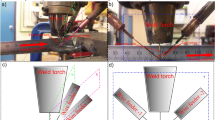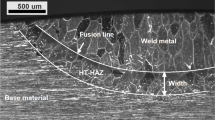Abstract
The objective of the current work was to establish the effect of flux-cored arc welding (FCAW) parameters, such as welding current, contact-tip to workpiece distance (CTWD) and shielding gas type, on diffusible hydrogen content for single run, horizontal position, bead-on-plate welds using seamed and seamless rutile consumable wires. The work included an investigation of arc characteristics under typical welding conditions, using high-speed digital imaging and laser backlighting, in order to provide information on metal transfer and arc length. The work has shown that under most conditions investigated, the hydrogen levels for the seamed rutile wire were above the 10 ml/100 g specified by the consumable’s classification (H10). In contrast, the seamless wire met the requirements of the H5 classification for all welding conditions investigated. In general, lower diffusible hydrogen levels were achieved when using CO2 shielding gas, although the effect is less significant with the H5 seamless rutile wire. It is further concluded that the time that the wire resides in the resistive heating zone, tRHZ, and the arc length are important factors in determining diffusible hydrogen content.
Similar content being viewed by others
References
N. Yurioka and H. Suzuki, “Hydrogen assisted cracking in C-Mn and low alloy steel weldments”, International Materials Reviews, Vol. 35, No. 4, 1990, pp. 217–249.
J.L. Davidson, “Hydrogen-induced cracking of low carbon — low alloy steel weldments”, Materials Forum, 19, 1995, pp. 5–51.
D. Dunne, “A review of the theoretical and experimental background of hydrogen assisted cold cracking of steel weldments”, in Proceedings of the 1st International Conference on Weld Metal Hydrogen Cracking in Pipeline Girth Welds, Wollongong, Australia, March, 1999, pp. 3–1.
AS/NZS 1554.1–2000, “Structural steel welding — welding of structural steel”, 2000.
ANSI/AWS D1.1–2000 “Structural welding code — steel” American Welding Society, Miami, Florida, 2000.
WTIA Technical Note 1, Weldability of steel, 1996.
D. Widgery, Tubular Wire Welding, Woodhead Publishing Ltd, Cambridge, 1994.
M. Sato, K. Suda and H. Nagasaki, “How to weld using flux-cored wires”, Japan Welding Society, 1996, 65(6), pp. 13–20.
M. Stemvers, “Cored wire benefits”, Proceeding of the ESAB Seminar: Welding of steels using flux-cored wires, Slovak Technical University, Trnava, April, 2001, pp. 11–20.
D. White, G. Pollard and R. Gee, “The effect of welding parameters on diffusible hydrogen levels in cored wire welding”, Welding and Metal Fabrication, June, 1992, pp. 209–216.
M.S. Sierdzinski and S.E. Ferree, “New flux cored wires control diffusible hydrogen levels”, Welding Journal, February, 1998, pp. 45–48.
T. Kurokawa, S. Nagaoka and T. Hashimoto, “Characteristics of newly developed flux-cored wire for mild and high tensile strength steels”, Kobelco Technology Review, No. 21, April, 1988, pp. 30–34.
M.A. Quintana and D.J. Kotecki, “Achievements and perspectives for the new millennium”, 53rd IIW Annual Assembly, July, 2000.
G.M. Evans and H. Baach, “Hydrogen content of welds”, Metal Construction, October, 1975, pp. 508–511.
M. Pitrun, J.L. Davidson, C.J. Kenny, P.J. Wittke and N. Cornish, “Factors affecting the hydrogen content of weld metal deposited by flux cored arc welding consumables”, Australian Welding Journal, Volume 46, 1st Quarter, 2001, pp. 33–48.
H.W. Lee, S.W. Kang and D.S. Um, “A study on transverse weld cracks in thick steel plate with the FCAW process”, Welding Journal, December, 1998, pp. 503–510s.
R.J. Pargeter, “Effects of arc energy, plate thickness and preheat on C-Mn steel weld metal hydrogen cracking”, TWI Report 461, November, 1992.
P.J. Konkol, J.L. Warren and P.A. Hebert, “Weldability of HSLA-65 steel for ship structures”, Welding Journal, September, 1998, pp. 361–371s.
R. Kuebler, M. Pitrun and I. Pitrun, “The effect of welding parameters and hydrogen levels on the weldability of high strength Q&T steel welded with FCAW consumables”, Australian Welding Journal, Volume 45, 1st Quarter, 2000, pp. 38–47.
V. Visman, “Weld metal HACC in thick section, low strength multipass FCAW”, Honours Thesis, University of Wollongong, 2002.
D. White, G. Pollard and R. Gee, “The effect of welding parameters on diffusible hydrogen levels in cored wire welding”, Welding and Metal Fabrication, June, 1992, pp. 209–216.
J.H. Kiefer, “Effects of moisture contamination and welding parameters on diffusible hydrogen”, Welding Journal, May, 1996, pp. 155–161s.
D.D. Harwig, D. Longernecker and J. Cruz, “Effects of welding parameters and electrode atmospheric exposure on the diffusible hydrogen content of gas shielded flux cored arc welds”, Welding Journal, September, 1999, pp. 314–321s.
AS/NZS 3992–1998 “Pressure equipment — welding and brazing qualification”, 1998.
J. Norrish, “Advanced welding processes” Institute of Physics Publishing, ISBN 0-85274-326–2, 1992.
W. Lucas, “Choosing a shielding gas — Part 2”, Welding and Metal Fabrication, July, 1992, p. 269.
B. Irving, “Trying to make some sense out of shielding gases”, Welding Journal, May, 1994, pp. 65–70.
N. Stenbacka and K.A. Persson, “Shielding gases for gas metal arc welding”, Welding Journal, November, 1989, pp. 41–47.
G.O. Schumann and I.E. French, “Influence of welding variables on weld metal from microalloyed, rutile flux cored wires”, CRC for Materials Welding and Joining Report, No. MTA290, January, 1994.
V. van der Mee, “Effect of atmospheric storage condition on weld metal diffusible hydrogen content of gas shielded cored wires. A brief study for IIW Sub-Commission II-A”, IIW Document II-1437–01.
AS 2203.1–1990, “Cored electrodes for arc welding — ferritic steel electrodes”, 1990.
ANSI/AWS A5.20–95, “Specification for Carbon Steel Electrodes for Flux Cored Arc Welding” American Welding Society, Miami, Florida, 1995.
ISO 3690–2000, “Welding and allied processes — determination of hydrogen content in ferritic steel arc weld metal”, 2000.
ANSI/AWS A4.3–93 “Methods for Determination of the Diffusible Hydrogen Content of Martensitic, Bainitic and Ferritic Steel Weld Metal Produced by Arc Welding” American Welding Society, Miami, Florida, 1993.
Author information
Authors and Affiliations
Rights and permissions
About this article
Cite this article
Pitrun, M., Nolan, D. & Dunne, D. Diffusible Hydrogen Content in Rutile Flux-Cored Arc Welds as a Function of the Welding Parameters. Weld World 48, 2–13 (2004). https://doi.org/10.1007/BF03266408
Published:
Issue Date:
DOI: https://doi.org/10.1007/BF03266408




